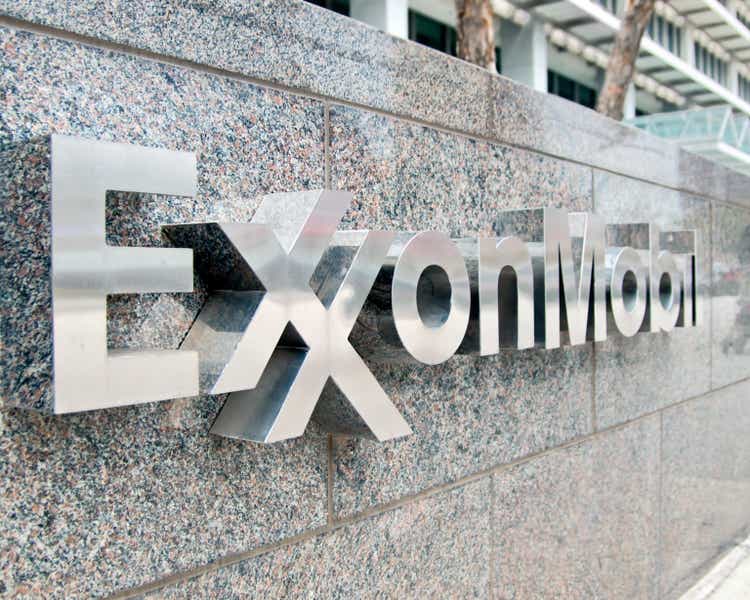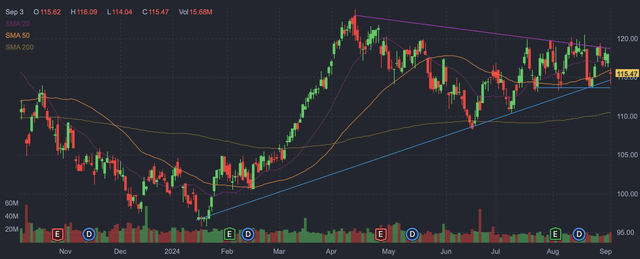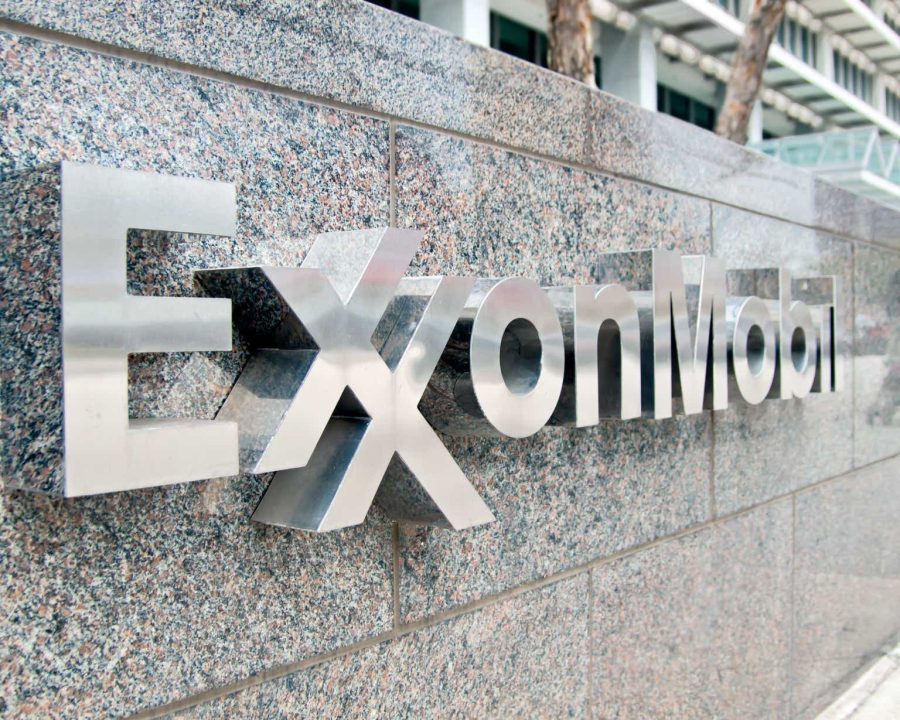Summary:
- Exxon Mobil shares are at the bottom of their trading range, offering reasonable value and a well-covered, potentially growing dividend.
- Q2 2024 earnings beat expectations with strong upstream performance, while the Pioneer acquisition boosts Permian Basin production and potential cost synergies.
- Exxon Mobil’s capex is capped, and the company is ensuring dividend safety even if oil prices drop significantly.
- Risks include lower commodity prices, geopolitical tensions, and potentially higher costs in capital projects, but shares have strong support and potential upside.
Lanier
Exxon Mobil Corporation (NYSE:XOM) has recently declined along with oil and the energy sector, but shares appear to now be sitting at the bottom of their trading range. Exxon Mobil offers reasonable value here, as well as a well-covered dividend that has the potential to grow in coming years if oil and gas prices can maintain current levels, especially if these commodities were to increase. Further, it appears as though XOM shares have another level of strong support just below where, where shares are likely to at least temporarily stop upon any potential breach of the apparent trading range. For these reasons, Exxon Mobil presents a reasonably strong value at risk here.
Exxon Mobil reported Q2 2024 earnings in early August. XOM’s quarterly EPS came in at $2.14, which was about 5-6% greater than the high end of Wall Street expectations for $1.98 to $2.03. Upstream production came in at 4,358 kboe/d and liquids production of 2,984 kboe/d were both above expectations by around four percent. Further, Exxon Mobil’s cash capex was $6.24 billion, which was below consensus expectations for capex of slightly over $6.4 billion.
While all four of Exxon Mobil’s primary segments were profitable, the company’s true strength came through upstream, where it earned just over $7 billion, well above Wall Street’s estimate for about $6-6.4 billion. This was a significant beat by XOM’s largest segment, whose earnings were roughly 10% greater than expectations. Energy products brought in about $946 million, which was 20-25% below expectations, and chemical products brought in about $779 million, which was roughly 13% below expectations. Specialty products performed roughly in line with or slightly below expectations by bringing in $750 million in earnings during the quarter. Any weakness seen by energy and chemical products was more than made up by the upstream beat.
During the prior quarter, Exxon Mobil closed on the acquisition of Pioneer Natural Resources, which was an all-stock purchase for about $60 billion. This deal significantly increased Exxon Mobil’s Permian Basin production to about 1.3 million barrels of oil equivalent per day and the Permian Basin now accounts for roughly one-third of Exxon Mobil’s total upstream production. Exxon Mobil appears to intend to further develop the company’s Permian Basin production through efficient and aggressive development of Pioneer’s assets.
Last year, Exxon Mobil indicated that its cost of running wells in the Permian Basin was lower than Pioneer’s expense and that this differential may result in a 15% cost synergy. If this turns out to be the case, Exxon Mobil has the chance to both increase upstream production and margins over the next several years, although margins will also be driven by the capricious nature of energy pricing. Even if margins remain stable, it appears likely that Permian Basin production could grow by 10% per year for the next three to four years, and possibly greater. Exxon Mobil hopes for the company’s Permian Basin assets to yield about 2 million barrels of oil equivalent per day by 2027.
Exxon Mobil guided that it has capped its spending to $20-$25 billion per year through 2027, but that was prior to current plans regarding Permian Basin development. Nonetheless, it is unlikely that even if Exxon Mobil opts to quickly ramp up Permian Basin production its capex would surpass 30 billion, and is likely to be less than $28 billion in each of the next two years, and still potentially under $25 billion. At this rate, XOM’s dividend appears wholly safe, even if oil prices were to decline by as much as 40 percent. If Exxon Mobil is capable of accomplishing its Permian Basin goals for production and 15% cost synergies over Pioneer’s costs, as well as its other production initiatives, the company should be able to cover the dividend even if energy prices halved from current levels. Moreover, if energy prices do not sustain such declines, the dividend is likely to grow over this timeframe.
In addition to the Permian Basin, Exxon Mobil’s profitability should substantially benefit from bringing online Guyana production that should run at higher margins. Precise timing on the ramping of such production is still uncertain. Exxon Mobil is likely to provide updates to capex and earnings guidance in December, and I expect that the company will provide a conservative estimate that it can protect the 2025 dividend so long as Brent pricing remains above $50 per barrel, and this number could fall to $45 per barrel in 2026.
Exxon Mobil also continues to reduce its total share count through regular repurchasing. Over the last 25 years, or since the merger of Exxon and Mobil, the company has reduced its share count from about seven billion shares, down to 4.1 billion at the end of 2023. The share count increased due to the acquisition of Pioneer, and was up to 4.44 billion at the end of the last quarter. Exxon Mobil’s plans for future repurchasing may be at least partially influenced by the forthcoming presidential election, given that the current administration instituted a one percent tax on share repurchases, which could be increased, repealed, or maintained. Still, it appears likely that Exxon Mobil will buy back between $15-$20 billion in shares over the next year.
I believe Exxon Mobil shares have a fair value of roughly $135 to $140 per share, and that this level has the strong potential to increase if the company’s Guyana business ramps efficiently, or if its specialty products and refining production margins outperform. This value estimate is predicated on Exxon Mobil forecasting 2025 EBITDA of at least $85 billion, and presuming a conservative fair value for XOM shares is at 7-7.5x EBITDA.
Exxon Mobil shares seem to be at the bottom of their recent trading range. Since peaking in the mid $120s in April, shares have largely been stuck in a fairly tight and narrowing trading range. Since mid-July, shares have largely remained between $113 and $120 per share. Further, prior to this, XOM shares bounced off the $110 range in both June and July. Therefore, it appears that shares are unlikely to break $113 in the near term, and that even if they do, they are likely to find strong support at around $110.
XOM daily candlestick chart (Finviz.com)
Risks
Exxon Mobil faces many risks, several of which are rather obvious. The clearest risk to Exxon Mobil is that of lower commodity prices, especially if they are caused by a significant reduction in global demand for petroleum-based energy and other products. The primary concern in terms of demand destruction would likely come from Asia, where demand levels are more sensitive to economic conditions. Other geopolitical risks also have unpredictable effects on energy pricing and demand, where conflict often causes prices to spike, but not always. For example, recent tensions in the Middle East appear to be coinciding with falling energy pricing.
Other risks include the possibility of higher than budgeted costs being incurred on Exxon Mobil’s capital projects, such as Guyana and the Permian Basin. Similarly, there remains the overhang of the dispute between Chevron Corporation (CVX) and Exxon Mobil over Hess’ 30% stake in Guyana. Exxon Mobil claims it has a right of first refusal to that stake. It appears the market is already anticipating Chevron will largely prevail in that dispute, so there should not be much downside risk to that result, or it is likely already mostly priced into shares, but that is not certain.
Conclusion
Exxon Mobil shares appear to be in a tight trading range that is just above strong support. I believe that shares have a fair value that is roughly 15-20% above current trading levels. Given that shares could soon reprice to reflect such a value, while also currently trading at what seems to be roughly 3-5% over a reasonably strong support level, Exxon Mobil presents a reasonable value at risk.
Analyst’s Disclosure: I/we have no stock, option or similar derivative position in any of the companies mentioned, but may initiate a beneficial Long position through a purchase of the stock, or the purchase of call options or similar derivatives in XOM over the next 72 hours. I wrote this article myself, and it expresses my own opinions. I am not receiving compensation for it (other than from Seeking Alpha). I have no business relationship with any company whose stock is mentioned in this article.
Seeking Alpha’s Disclosure: Past performance is no guarantee of future results. No recommendation or advice is being given as to whether any investment is suitable for a particular investor. Any views or opinions expressed above may not reflect those of Seeking Alpha as a whole. Seeking Alpha is not a licensed securities dealer, broker or US investment adviser or investment bank. Our analysts are third party authors that include both professional investors and individual investors who may not be licensed or certified by any institute or regulatory body.
